When choosing a natural fence, consider evergreens like Arborvitae, Green Giants, Leyland Cypress, Boxwood, Juniper, and Cedar for year-round privacy and less maintenance. Deciduous options like Dogwood, Beech, Maple, Oak, and Burning Bush offer seasonal beauty but lose winter coverage. Evergreens grow faster (2-5 ft/year) and provide better noise reduction, while deciduous varieties create dynamic ecosystems. Your climate zone and privacy needs will guide your perfect natural boundary solution.
7 Best Evergreen Vs Deciduous Natural Fence Options
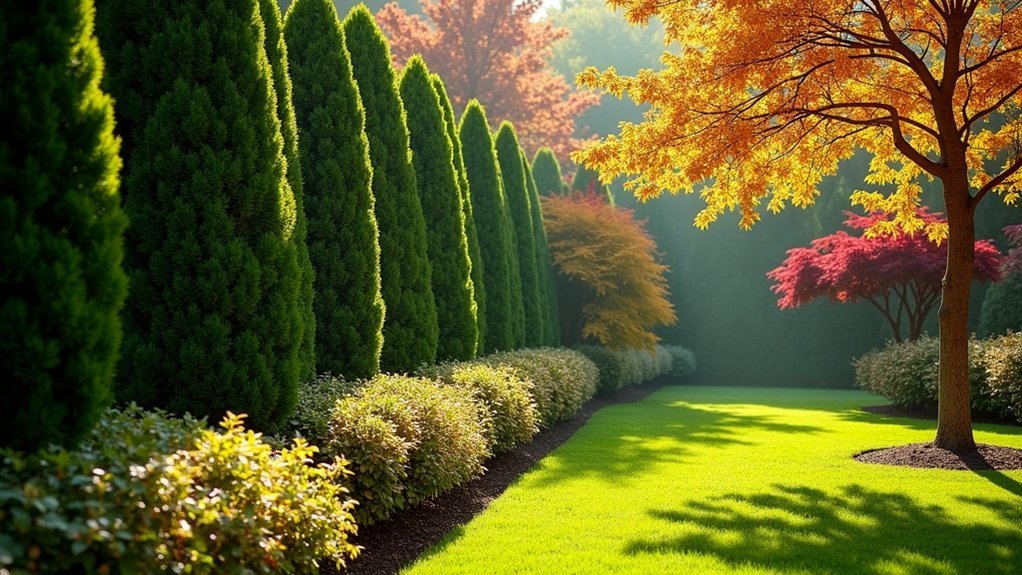
When choosing between evergreen and deciduous options for a natural fence, you’ll need to weigh several essential factors that impact both immediate satisfaction and long-term success.
Evergreens like Green Giant Arborvitae and Leyland Cypress offer faster privacy, typically reaching 10-25 feet within 10-15 years, while maintaining year-round screening. They generally require less maintenance once established.
In contrast, deciduous options like dogwoods and crabapples provide seasonal interest with blooms and fruits but lose their leaves in winter and take 8+ years to form full screens.
Consider your climate needs too—White Spruce tolerates temperatures to -40°F, while Leyland Cypress thrives in southern heat. For urban environments, Green Giant Arborvitae’s dense foliage effectively blocks noise from busy streets.
Your budget matters as well, with mature evergreens ranging from $40-$150 per tree versus $20-$50 for deciduous shrubs.
Dense Arborvitae vs. Flowering Dogwood: Privacy Comparison
Homeowners looking for natural fence solutions often find themselves weighing the merits of two popular options: Arborvitae and Flowering Dogwood. Your choice between these two depends largely on your privacy needs and aesthetic preferences.
| Feature | Arborvitae | Flowering Dogwood |
|---|---|---|
| Year-round privacy | Excellent | Limited in winter |
| Growth rate | Fast (2-5 ft/year) | Moderate |
| Mature height | 15-40 feet | 15-30 feet |
| Maintenance | Minimal pruning | Less regular pruning |
| Visual appeal | Consistent green | Seasonal flowers & color |
If year-round screening is your priority, you’ll want to choose Arborvitae with its dense evergreen foliage. Dogwood offers stunning seasonal beauty with spring blossoms and fall color but sacrifices winter privacy when leaves drop. Eastern White Cedar (Arborvitae) provides an effective long-term solution for urban crowding with its dense growth pattern. Arborvitae also grows faster and taller, providing quicker screening solutions.
Year-Round Green Giants vs. Seasonal Beech Hedges
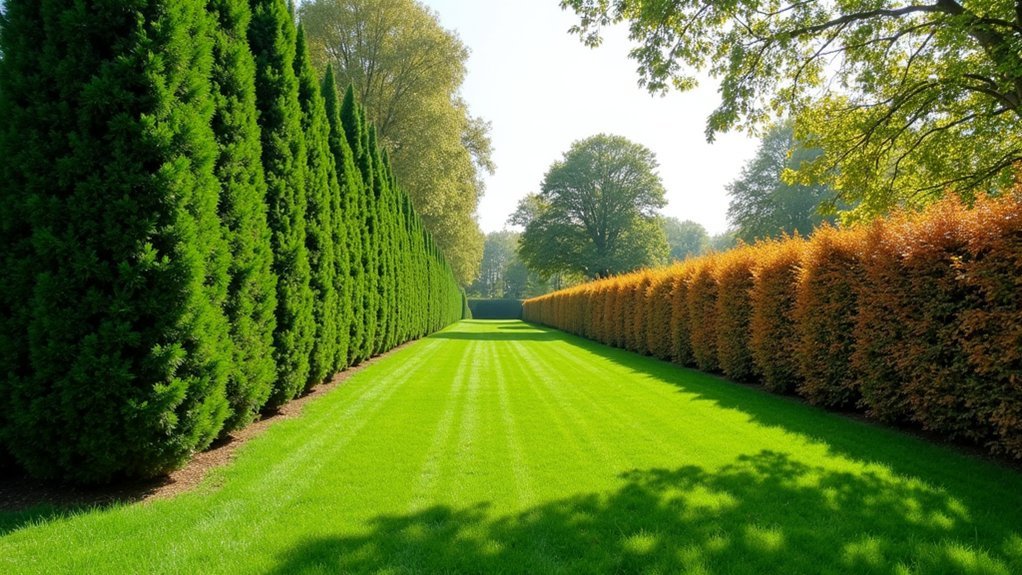
You’ll notice a stark difference between evergreen giants and beech hedges when winter arrives, as your Green Giants stand tall with full privacy while beech leaves drop to reveal partial visibility.
Your maintenance costs will differ considerably too, with evergreens requiring consistent year-round care versus the seasonal demands of beech hedges that need intensive fall cleanup.
While you’ll pay more upfront for mature evergreen specimens, their faster growth and continuous screening value often justify the investment compared to the seasonal appeal of beech. The combination of both tree types in your natural fence design creates visual interest throughout the year, with deciduous beech providing fall color and evergreens maintaining consistent structure.
Privacy War: Winter Edition
Winter reveals the true champions in the natural fencing world, separating the steadfast evergreens from their deciduous counterparts.
When snow falls and temperatures drop, your privacy needs don’t hibernate.
Evergreen options like Emerald Green Arborvitae, Thuja Green Giant, Leyland cypress, and Nellie Stevens holly maintain their dense screening capacity year-round.
You’ll enjoy uninterrupted seclusion regardless of season.
Meanwhile, deciduous choices like beech hedges shed their leafy cover, leaving you exposed through bare branches until spring returns.
Though they offer stunning autumn displays and greater biodiversity benefits, you’ll sacrifice winter privacy.
For thorough year-round screening, evergreens are your clear winners, equipped with special adaptations that help them withstand freezing conditions while keeping prying eyes at bay.
Your winter privacy depends on this essential distinction.
Evergreens also provide additional benefits as they act as effective windbreaks during harsh winter months, reducing heating costs for your home.
Maintenance Cost Comparison
When comparing maintenance costs between evergreen and deciduous options, the financial commitment extends far beyond initial planting expenses.
You’ll face higher upfront costs with evergreens like arborvitae and cypress, but their year-round foliage means less seasonal cleanup.
Deciduous varieties demand significant fall cleanup as leaves drop, increasing your seasonal maintenance burden. However, they require less frequent care during other seasons, balancing the maintenance equation.
Over time, evergreens’ low maintenance needs can translate to substantial savings on pruning and care. Mature evergreen hedges can significantly increase your property’s resale value by up to 5% compared to traditional fencing options. While they take years to reach full privacy potential, their durability often outlasts traditional fencing, providing better long-term value.
Your choice affects more than your wallet—evergreens offer consistent privacy and wind protection while deciduous options deliver changing seasonal interest and potentially faster initial growth.
Fast-Growing Leyland Cypress vs. Color-Changing Maple Barriers
When choosing between Leyland Cypress and Maple barriers, you’ll need to weigh immediate privacy against seasonal beauty.
Leyland Cypress offers quick, year-round screening with minimal upkeep, growing about 3 feet annually with its dense foliage requiring only occasional pruning. The conical shape and soft, feathery needles make Leyland Cypress an attractive option that blends well with various landscape designs.
Maple barriers demand more maintenance with seasonal leaf cleanup but reward you with stunning color changes that Leyland’s consistent green appearance can’t match.
Privacy vs. Beauty Balance
Choosing between privacy and beauty doesn’t have to be an either-or decision when planning your natural fence.
Leyland Cypress offers quick results, growing up to 3 feet annually with dense foliage that provides year-round screening, even in harsh conditions.
Maples, while less effective for complete privacy (especially in winter when leaves drop), reward you with spectacular seasonal transformations. Their vibrant fall colors create dynamic visual interest that uniform evergreens can’t match.
Your choice ultimately depends on priorities. If immediate, consistent screening is paramount, Leyland’s evergreen qualities make it ideal. Consider Thuja Green Giants as an alternative that provides excellent privacy with rich textured foliage and better cold hardiness down to -20°F.
If you’re willing to sacrifice some winter privacy for dramatic seasonal beauty, Maples deliver unmatched aesthetic appeal.
Consider your specific landscape needs, available space, and the balance between privacy requirements and desired visual impact.
Maintenance Effort Comparison
Both Leyland Cypress and Maple trees demand considerably different maintenance commitments over their lifespans, affecting your long-term landscaping experience.
You’ll find Leyland Cypress requires less routine attention, growing rapidly at 3-5 feet annually with minimal pruning needs unless used as a hedge. Since Leyland Cypress can reach 40 to 60 feet tall at maturity, plan adequate spacing when designing your natural fence. However, you’ll need to provide regular deep watering, especially during establishment, and guarantee good drainage to prevent root rot.
Maples grow more slowly but demand regular pruning to maintain shape and prevent disease. They’re more adaptable to varying soil conditions and typically more drought-resistant than Leyland Cypress.
You’ll need to fertilize maples annually, while Leyland Cypress only requires supplementation in nutrient-poor soils.
For pest management, watch for spider mites on Leyland Cypress and aphids on maples.
Low-Maintenance Boxwood vs. Wildlife-Friendly Oak Borders
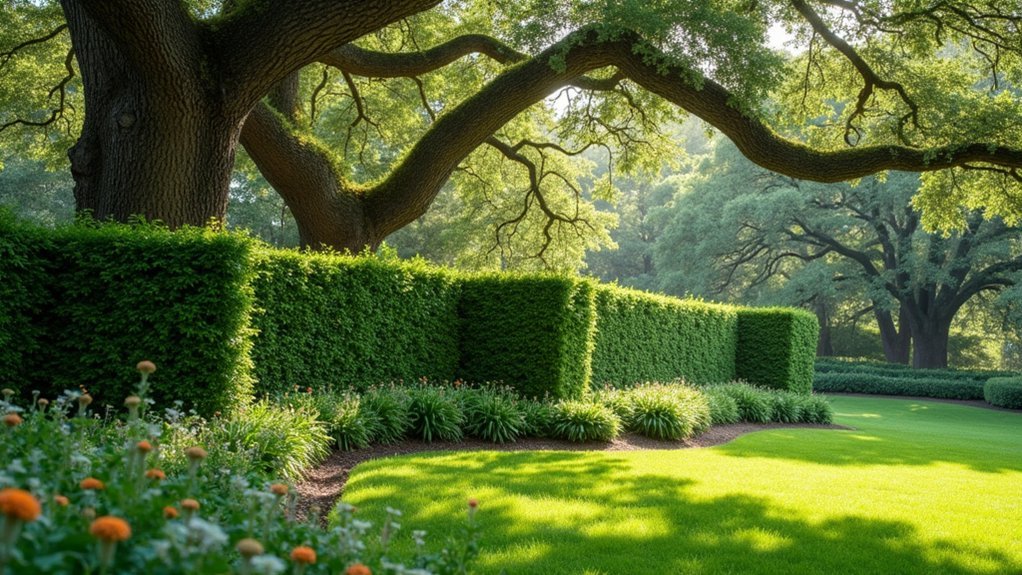
The natural tension between aesthetic consistency and ecological value emerges clearly in the choice between boxwood and oak borders.
Boxwood offers year-round greenery with its evergreen nature, requiring regular pruning but rewarding you with versatile shaping options and weather resistance. Just as with traditional wood fencing, considering your local climate conditions will significantly impact which option performs better in your area.
You’ll enjoy consistent privacy and a manicured appearance that can be tailored to your design preferences.
Oak borders, while deciduous and requiring seasonal maintenance with staining and weather treatments, create vibrant ecosystems.
They’ll attract birds and insects with their acorns and natural habitat properties.
Though initially more expensive, oak’s durability can offset higher maintenance costs over time.
Your decision ultimately depends on priorities: boxwood for year-round structure and lower pest vulnerability, or oak for biodiversity support and natural aesthetic appeal despite seasonal leaf loss.
Deer-Resistant Juniper vs. Autumn-Glory Burning Bush
When considering fence options for deer-prone areas, juniper and burning bush present starkly different approaches to both protection and visual appeal.
Juniper offers superior deer resistance with its aromatic oils and prickly foliage, while burning bush may suffer browsing damage during food-scarce seasons.
You’ll find distinct seasonal characteristics between these options:
- Juniper maintains blue-green foliage year-round for consistent privacy
- Burning bush delivers spectacular scarlet autumn color but leaves winter gaps
- Juniper’s drought tolerance (zones 2-9) outperforms burning bush’s narrower adaptability (zones 4-8)
- Fire safety concerns plague juniper due to oil content and accumulated dead wood
- Burning bush’s invasive status restricts shipping to many states and threatens native ecosystems
Common Juniper typically reaches 3 to 4 feet tall, making it more manageable for natural fence applications compared to other varieties.
Consider your local deer pressure, maintenance capacity, and ecological responsibility when making your selection.
Cost-Effective Cedar Screens vs. Dynamic Deciduous Mixes
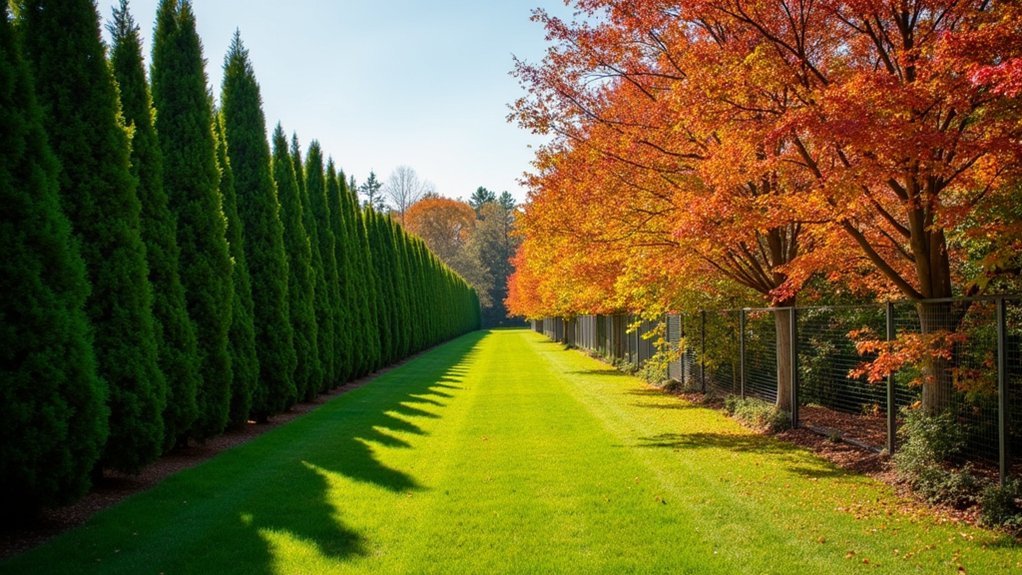
Comparing natural fence options purely on cost-effectiveness requires looking beyond initial installation expenses to long-term value.
Cedar screens, while pricier upfront at $15-$35 per foot installed, offer exceptional durability lasting up to 30 years with minimal maintenance.
You’ll appreciate cedar’s natural resistance to insects and rot, eliminating the need for chemical treatments. Western Red Cedar particularly excels in durability and comes in various styles from picket to privacy fencing. Choosing premium grades of cedar ensures better appearance and increased durability, though at a higher price point.
While deciduous mixes provide seasonal visual interest with changing colors and textures, they typically demand more ongoing maintenance due to leaf drop and pruning requirements.
Cedar maintains consistent year-round appearance and structure.
For long-term investment, cedar’s longevity, minimal upkeep, and potential to increase property value make it the more cost-effective solution despite higher initial costs.
Frequently Asked Questions
How Do Natural Fences Affect Property Boundaries and Neighbor Relations?
Natural fences clearly define your property lines, reducing boundary disputes. They’re visually appealing, provide privacy, and can foster positive relations with neighbors through shared appreciation and maintenance responsibilities.
Can Mixed Evergreen-Deciduous Hedges Withstand Extreme Weather Conditions?
Yes, you’ll find mixed evergreen-deciduous hedges are exceptionally resilient to extreme weather. The evergreens provide year-round protection while deciduous plants adapt to seasonal changes, creating a hedge that’s stronger against diverse climate challenges.
What Spacing Is Ideal When Planting Different Types of Natural Fences?
For natural fences, space evergreens at half their 10-year width: Emerald Green Arborvitae 4 feet apart, Green Giant 6-8 feet apart. For deciduous hedges, plant closer together (about 18 inches) to create a dense screen.
How Do Natural Fences Compare to Traditional Fencing for Noise Reduction?
While your natural fence absorbs some sound, it’s less effective than solid traditional fencing. Traditional materials like masonry and vinyl provide better noise reduction due to their density and continuous barrier design that deflects sound waves effectively.
Are There City Regulations Limiting Height or Placement of Living Fences?
Yes, your living fence is typically subject to the same height restrictions as traditional fences—usually 3-4 feet in front yards and 6-8 feet in side/rear yards. You’ll need to check your specific city regulations.
In Summary
Whether you choose year-round privacy with evergreens or seasonal beauty with deciduous options, you’ll find a natural fence that suits your needs. Consider your climate, maintenance preferences, and aesthetic goals when making your selection. Remember that evergreens offer constant screening while deciduous varieties provide changing scenery. Your perfect living boundary might even combine both types, giving you the best of both natural fence worlds.

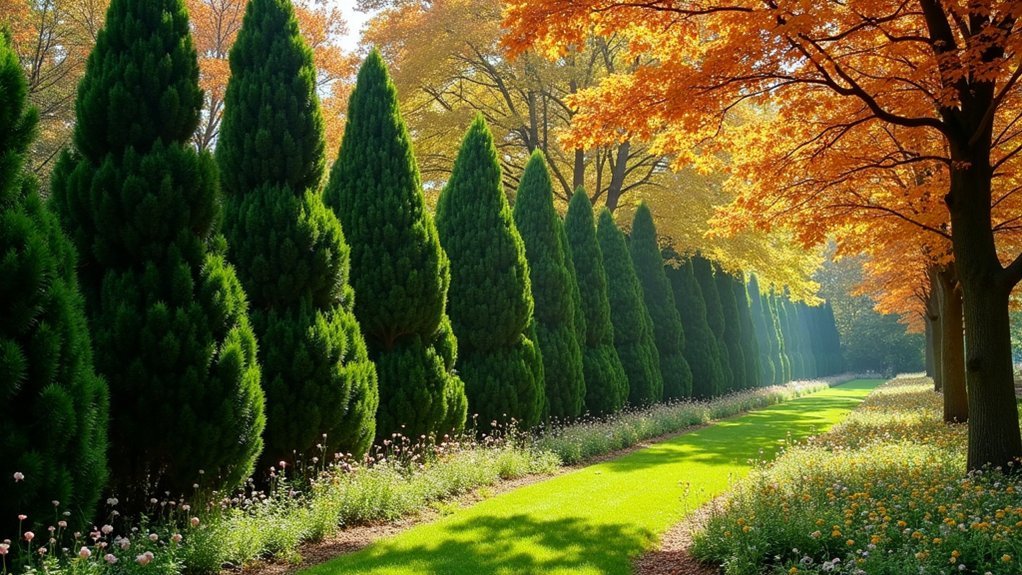



Leave a Reply